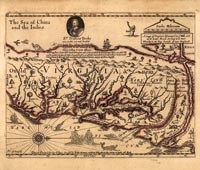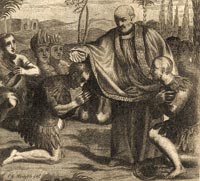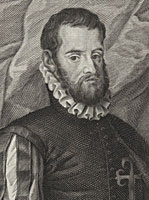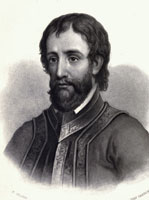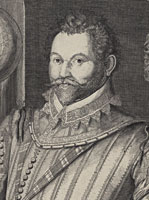Online Extras
The Age of Exploration

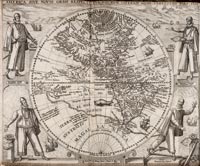
Beinecke Library, Yale University
Theodore De Bry’s 1596 map of the New World. Columbus, Vespucci, Pizarro, and Magellan, with the dates of their voyages, stand in the quadrants.
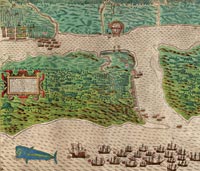
Library of Congress
The Spanish secured footholds in the American hemisphere well before the British, including St. Augustine, where English ships and troops attacked in 1586.

Library of Congress
With Spanish troops, Cortez meets Aztecs in Mexico City, where he leveled native structures and built a European city on the ruins.
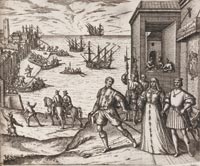
Beinecke Library, Yale University
Ferdinand and Isabella see Columbus off on the voyage that landed him in the New World.
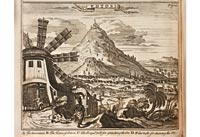
Barbara Lombardi
The Bolivian city of Petosi sat beneath the Cerro Rico, the "Rich Mountain," with mines that produced silver for Spanish.
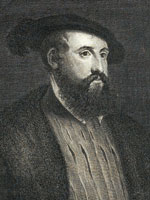
Library of Congress
In the Age of Exploration, Spain, France, and England competed to establish global empires and dispatched adventurers and explorers to stake their claims. Cortez
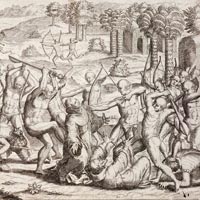
Beinecke Library, Yale University
The clash between native peoples and Europeans was often deadly. Indians club a Spanish priest.

The clash between native peoples and Europeans was often deadly. Spaniards hang Indians who had killed soldiers; some escaped by jumping ship.
Why did not those earlier European owners offer a stouter resistance? They were rivals worthy of England and had much in common with her: fed with the same food, hurt with the same weapons, subject to the same diseases, healed by the same means, warmed and cooled by the same summer and winter.
Why Virginia Was Not Spanish
by Anthony Aveni
A look at a late sixteenth-century map of Spanish-controlled territory suggests every part of the Americas would end up Hispanic. Then the most powerful empire in the world, Spain claimed lands in the Americas from Argentina north through Central America and Mexico, the Caribbean islands, and all the territory up to 200 miles in and along today’s United States coast from the Texas-Mexico border to the New Jersey coast. Her inland North American claims encompassed all the Florida peninsula, huge chunks of Louisiana, Mississippi, South Carolina, and the Tidewater coast, including the Delmarva Peninsula.
The earliest motive driving the Spanish program of New World exploration was the hope of finding a passage to the Spice Islands off the East Asian coast. Later they turned attention to acquiring the wealth of precious metals and stones they had heard existed deep in the interior of both American continents. Still later came the objective of Christianizing the Indians. Columbus wrote in his diary that he was ordained by God: “Of the new heaven and the new earth which the Lord made, and of which St. John wrote in the Apocalypse . . . he made me the messenger and he showed me the way.” Dictating religious beliefs, moreover, was a part of the divinely ordained monarch King Charles V’s mission of controlling the economy.
Spain’s interest in countering French land claims and privateers—armed private ships commissioned by sovereign powers to cruise against an enemy’s commerce—also attracted it to the North American east coast. These privateers, or pirates, as we call them today, sought to commandeer shipments of gold and silver from Mexico and Peru making their way toward the Spanish treasury northward along the Gulf Stream in galleons. This is where explorations of and claims to Virginia, then known as Xacan or Jacan—possibly derived from Occoquan—came into the picture.
Spain’s surge to international prominence began at the end of the fifteenth century with the overthrow of the Moors and the unity of the crowns of Castile and Aragon under Roman Catholicism. This happened during the generation when new lands were being discovered abroad. That protracted war left members of the Military Order, who had long fought the battle of the faith, restless and in need of satisfying their finely honed appetite for adventure. These fighting men, who also craved wealth and fame, would become the conquistadors of the Americas: Cortez in Mexico, Pizarro in South America, and Ponce de Léon and DeSoto in North America.
“We were going in search of a land that an Indian boy had told us was on another sea. . . . He said that he was from another land . . . and that a woman ruled it. Her town was of wonderful size . . . and she collected gold in abundance from her chiefs.” So wrote one of Hernando DeSoto’s men. Given the treasures Cortez and Pizarro had found, it made sense to search for riches in the North American interior. Commissioned by Charles V, conquistador DeSoto and his all-volunteer crew of 620 set out from Tampa Bay in 1539 to found a colony for processing the expected riches. The expedition proceeded up the Florida peninsula into Central Georgia, western North Carolina, and eastern Tennessee, then to the south across northern Mississippi and down the Great River. DeSoto seized the Indian chief at every village he came to, along with food and other supplies, as well as native slaves he used for porters.
Though DeSoto’s expedition failed to find the anticipated North American treasure, his discovery of the Mississippi is key to the Virginia claims. Vasco Nuñez de Balboa was the first European to discover the Pacific in 1513. DeSoto noted that a great circle drawn over the globe from Havana to the Orient ran directly up the Mississippi. He believed that, followed upstream, the river would lead to the Great Northern Sea. He theorized that settlements could be established along the route leading to a colony that might be founded on the west coast. From that place one could sail the Pacific to China. Or did a shortcut to the Mississippi exist, a navigable route directly inland from the east coast of North America? DeSoto died before he could develop his geographical theory into a program of exploration.
In Spain’s earliest incursion of Virginia in 1524, Luis Vásquez de Ayllon penetrated the James River and Chesapeake Bay. In 1526, with the intention of exploring further inland, he founded a small settlement, which he named San Miguel de Guandape. It lay close to where Jamestown would be settled by the British eight decades later. Incidentally, Vásquez de Ayllon’s use of African slaves in this task marks the first instance of slavery on the United States mainland. The colony failed; barely a third of the 600 people who had occupied it for the few years of its existence survived passage back to Havana.
Of all the conquistadors, Pedro Menéndez de Aviles, the founder of St. Augustine, was the most influential when it came to exploring Virginia. Born in 1519 to one of the most steadfast families to serve the Catholic kings in the war against the Moors, in 1560 Don Pedro gained an appointment as Captain General of the Fleet of the Indies. The fleet was a convoy of four galleons, eight merchantmen, and two couriers led by Menéndez de Aviles’s ship, with that of the admiral, second in command, sailing rearguard. Their mission, of vital importance to the Spanish crown, would be to transfer the wealth of the Americas to the Spanish treasury, keeping that country first among the European powers.
By 1565 the Spanish had established St. Augustine and five other settlements on the coast of the Florida peninsula. Meanwhile, the French had gained a foothold on the gold route by building Charlesfort in 1562, on the site of today’s Parris Island Marine Base in South Carolina. On his second trip, Menéndez seized the French base and converted it into a safe refuge harbor for the now well-established Treasure Fleet. Archaeologists discovered the fort’s location in 1996.
Carried away by his success, Menéndez imagined himself the head of an empire rid of French influence that would extend over all of North America. He wrote to the king:
Considering these lands to be of so great an extent and the climate so good, and the injury and disturbance which enemies and corsairs can cause them every day, and how they can possess themselves of the countries to the north of here, near Newfoundland, where they are masters by violence, and can easily maintain themselves, the following is what should be done in particular.
Menéndez proposed to move north up the coast to the Bay of Santa Maria in latitude 37°, or the Chesapeake Bay. Like DeSoto, Menéndez believed that the sea extended southeasterly up the St. Lawrence River, ending at a mountain range about eighty leagues, roughly 240 miles, north of the Chesapeake Bay. He persuaded himself that one of the northwest branches of the bay, possibly the Potomac River, was the gateway to the Northwest Passage to China and the Moluccas by way of the Pacific. No one knows what Menéndez thought to be the shape of North America. Did it taper to a narrow isthmus north of Chesapeake Bay? Some scholars who have studied early colonial maps think Menéndez de Aviles believed that the Chesapeake and the St. Lawrence were somehow connected, and that an area of the upper Mississippi and Missouri hooked up with the Pacific. One map shows Hudson Bay extending southward almost to the New Jersey coast.
In 1561, Menéndez paid his first visit to Chesapeake Bay. He did not find the best entrance, but while looking seized a seventeen-year old Indian named Paquiquino, later baptized Don Luis de Velasco, the son of a chief. Paquiquino and a young companion became the first Virginians to cross the Atlantic. Menéndez displayed them before the Spanish court to promote Spain’s New World exploits, and woo financial backers for American exploits.
In 1570, Menéndez authorized a Chesapeake expedition to establish a colony. Joining it as guide and translator was Don Luis, now in his late twenties, well traveled, and schooled in the Spanish Catholic tradition. A party of eight Jesuit priests and a novice sailed up the River of Powhatan—later named by the English the James—to a landing. Don Luis led them to a village headed by his younger brother. But to the surprise of the friars, Don Luis reverted to his native life ways. Within a few months of his return, he established himself as leader of a counterforce that ultimately wiped out the friars’ outpost except for a boy who escaped to tell the story. In reprisal, the next year a cadre of Spaniards returned and captured, killed, and displayed the bodies of Indians, hanging them from the ship’s mast. This event not only marked the last attempt at Spanish colonization in Virginia; it set the tone for future native contact with the European invaders. One historian has speculated that Don Luis became the enemy of the seventeenth-century English colonists, Opechancanough, who led the joint tribal rebellions of 1622 and 1644. The evidence, however, does not fully support this theory. Notwithstanding, the well-organized chiefdom of the Tidewater seems to have been aware, through this and other European contacts, of the negative foreign intentions by the time the English arrived four decades later.
British objectives for exploring North America were not so different from Spain’s. As one historian has remarked, “The object . . . was doubtless to search for minerals and for a route to the southwest, and to secure for trade the materials which were native and peculiar to those regions. . . . To establish a settlement which would be a market for English goods, to advance the shipping, to spread the religion of the kingdom. . . . ”
Though the English were late on the scene, they had a penchant for business, and their first settlers were indentured servants who worked land with the possibility of eventual ownership, and that rendered the newcomers the most successful of the American colonists. The first joint-stock companies were formed in the 1550s when Spain and England were bonded by the marriage of Mary with Philip of Spain. But in the Elizabethan reign that followed, the English became more independent minded. By the turn of the century their naval power exceeded Spain’s. Such privateers as Sir Francis Drake severely curtailed transatlantic Spanish commerce. Drake plundered Spanish settlements on the far side of the Isthmus of Panama and penetrated as far south as Peru, where Spanish ports came under constant attack and lengthy sieges. The success of the Protestant Reformation against Catholics also played a role in weakening Spain’s prominence as chief colonizer of the world. Advised by the discouraged Menéndez, in 1587 the Spaniards renounced all land claims north of St. Augustine. By the time the Jamestown and Massachusetts Bay colonies were established, Spain was out of the picture, and the British had risen to become the most powerful empire on Earth.
So why didn’t Virginia end up Hispanic? The best answer to the question may be that the Spanish felt no tie to the land. They failed in part because they didn’t practice agriculture, trying instead to survive on native harvests. They alienated the natives by stripping them of their winter stores and forcing them into servitude. Ill-timed bad winters and extended drought made matters worse. The cultivation of a negative native attitude toward the invader in the episode of Don Luis figured strongly against Spain’s attempts to gain a permanent foothold on North America’s Atlantic shores.
Bad attitude, bad luck, bad decision making— or was Virginia just destined to be English? As historian Woodbury Lowery has written:
The tiny wedge of gentlemen laborers, alien in religion and race to the two great Catholic and Latin Powers, would settle in Jamestown, and spread along the narrow strip of territory between the Alleghenies and the Atlantic. Then like an iron wedge, the English colonists penetrated the domain of their rivals, thrust them apart on either side, and with ever increasing dimensions pressed farther and farther across the continent, until they had occupied almost the entire territory, which had previously belonged to France and Spain.
Anthony Aveni is Russell Colgate Distinguished University Professor of Astronomy, Anthropology, and Native American Studies at Colgate University. His next book for children will be Buried Beneath Us: Discovering the Ancient Cities of the Americas, to be published in 2013 by Roaring Brook.
Suggestions for further reading:
- W. Lowery, The Spanish Settlements within the Present Limits of the United States, 1513–61 (New York, 1911).
- A. Mauncey, Pedro Menéndez de Avilés: Captain General of the Ocean Sea ((Sarasota, FL, 1992).
- W. Sturtevant, Spanish Indian Relations in Southwestern North America (Durham, NC, 1962).

